STATE OF NE W YORK COMMISSION ON JUDICIAL CONDUCT DETERMINATION
In the Matter of the Proceeding Pursuant to Section 44, subdivision 4, of the Judiciary Law in Relation to CARLOS M. CALDERON III, a Justice of the Milton Town Court, Saratoga County.
THE COMMISSION:
Honorable Thomas A. Klonick, Chair
Stephen R. Coffey, Esq., Vice Chair
Joseph W. Belluck, Esq.
Richard D. Emery, Esq.
Paul B. Harding, Esq.
Elizabeth B. Hubbard
Honorable Jill Konviser
Nina M. Moore
Honorable Karen K. Peters
Honorable Terry Jane Ruderman
APPEARANCES: Robert H. Tembeckjian (Robert H. Tembeckjian and Charles F. Farcher, Of Counsel) for the Commission; Gerstenzang, O’Hern, Hickey. Sills & Gerstenzang (by Thomas J. O'Hern) for the Respondent
The respondent, Carlos M. Calderon III, a Justice of the Milton Town Court. Saratoga County, was served with a Formal Written Complaint dated October 8, 2008, containing one charge. The charge alleged that respondent referred to his status as a judge in communications with prison officials asking them to confiscate documents from an inmate in furtherance of respondent’s personal interests. Respondent filed a verified Answer dated November 7, 2008. By Order dated January 15, 2009, the Commission designated Michael Whiteman, Esq.. as referee to hear and report proposed findings of fact and conclusions of law. A hearing was held on April 10 and May 11, 2009, in Albany. The referee filed a report dated October 16, 2009.
The parties submitted briefs with respect to the referee’s report and the issue of sanctions. Commission counsel recommended that the judge be censured, and the judge’s attorney recommended that the judge be admonished. Oral argument was waived. Thereafter, the Commission considered the record of the proceeding and made the following findings of fact.
1. Respondent has been a justice of the Milton Town Court, Saratoga County, since January 2006. He is not an attorney. Prior to assuming the bench. respondent was a New York State Trooper.
2. On February 24, 2005, as a State Trooper, respondent was involved in a high-speed pursuit of Octavio Rivera, who had stolen a motor vehicle. The chase ended with a collision between respondent’s police cruiser and the stolen car.
3. Mr. Rivera was charged with numerous crimes including Robbery, Driving While Intoxicated and Assault. At the trial, respondent testified against Mr. Rivera and was cross-examined by Mr. Rivera, who acted as his own attorney. Mr. Rivera was convicted, sentenced to 15 years imprisonment and remanded to Sing Sing Correctional Facility.
4. Prior to the sentencing, respondent received a letter from the Saratoga County Probation Department asking him to submit a Victim Impact Statement as part of its Pre-Sentence Investigation of Mr. Rivera and enclosing a form for that purpose. The cover letter stated that the Victim Impact Statement would be attached to the Pre-Sentence Report and would be “submitted to the Court, the Prosecutor, the Defendant’s attorney and the Defendant if he/she has no attorney.”
5. On November 30, 2005, respondent completed the Victim Impact Statement. Respondent described the accident and his physical injuries, indicated that he had not suffered any emotional injury and said that he had “forgiven and [was] moving on.” Respondent gave his home address on the form.
6. Respondent retired from the State Police in part because of injuries he suffered in the collision with Mr. Rivera.
7. On April 18, 2007, respondent commenced a personal injury action against Mr. Rivera in Saratoga County, alleging that he suffered physical injury and “mental anguish” as a result of the collision. Respondent was represented in his civil suit by an attorney.
8. Mr. Rivera sent to respondent a Notice to Admit pursuant to CPLR 3123, dated May 21, 2007, seeking an admission that the Victim Impact Statement, a copy of which was attached, and respondent’s signature on that document were genuine.
9. The Notice to Admit bore the caption and index number of respondent’s lawsuit and was clearly related to respondent’s personal injury action against Mr. Rivera.
10. The envelope bearing Mr. Rivera’s Notice to Admit was addressed to “Hon. Carlos Calderon” and was mailed to respondent’s home address. The Notice to Admit indicated on its face that copies were being sent to respondent, respondent’s attorney and the County Clerk of Saratoga County.
11. Respondent’s declaration in the Victim Impact Statement that he suffered no “emotional injury” as a result of Rivera’s crime was a potential defense to respondent’s claim in the civil suit that he suffered “mental anguish.”
12. Respondent’s attorney instructed him to disregard Mr. Rivera’s Notice to Admit.
13. After receiving Mr. Rivera’s correspondence, respondent telephoned Sing Sing Correctional Facility and spoke with Lieutenant Harry Kerrigan. Respondent told Lieutenant Kerrigan that he had received a letter at his personal residence from an inmate and that the letter was addressed to him as “Honorable Carlos Calderon.” The title “Honorable” was a reference to respondent’s judicial office.
14. Respondent asked that documents in Rivera’s possession containing respondent’s home address be confiscated and that his name be removed from Rivera’s mailing list. Lieutenant Kerrigan advised him that the request should be made in writing.
15. On or about May 27. 2007, respondent mailed copies of the Notice to Admit and the Victim Impact Statement that he had received from Mr. Rivera to Lieutenant Kerrigan, with a cover letter. This correspondence was sent in an envelope bearing respondent’s judicial title, Milton Town Justice, and a return address associated with the Milton Town Court.
16. Respondent’s letter to Lieutenant Kenigan referred to himself as “Hon. Carlos M. Calderon Ill” in the return address as well as the signature line.
17. In the first paragraph of the letter, respondent stated that he was a New York State Trooper for 23 years and that “I have since become a Town Judge in Saratoga County.”
18. Respondent’s letter to Lieutenant Kerrigan stated that Mr. Rivera had a copy of the Victim Impact Statement in his possession, requested that documents containing respondent’s home address be confiscated and destroyed, and requested further that lieutenant Kerrigan advise “the inmate correspondence program” at Sing Sing that respondent wished no further contact with Mr. Rivera. Respondent’s letter asserted that he had spoken with Saratoga County District Attorney James Murphy as well as members of the Saratoga County Department of Probation and that all agreed that Mr. Rivera improperly possessed the Victim Impact Statement.
19. Respondents communications to Lieutenant Kerrigan lacked candor in that respondent did not refer to his pending civil suit against Mr. Rivera or to the fact that a letter he had received from the Saratoga County Department of Probation had informed him that Mr. Rivera would have access to the Victim Impact Statement if he had no attorney.
20. Respondent asserted his judicial office in his communications with prison officials in an attempt to advance his own personal interests.
21. As a result of respondent’s repeated references to his judicial office, Sing Sing officials were made aware of respondent’s judicial status.
22. Respondent’s letter, postmarked May 29, 2007, arrived at Sing Sing Correctional Facility. As a result of respondent’s request, Mr. Rivera’s legal documents, including his copy of respondent’s Victim Impact Statement, were confiscated.
23. Respondent subsequently received a letter from William Lee, Deputy Superintendent of Sing Sing Correctional Facility, dated June 14, 2007, stating that various documents had been secured pursuant to respondent’s request. Deputy Lee’s letter noted the pending lawsuit against Mr. Rivera and requested that respondent submit “a response as to the appropriateness of Mr. Rivera’s possession of these documents.” Respondent did not reply to Deputy Lee’s letter.
24. Mr. Rivera’s documents were returned to him on September 6, 2007, more than three months after respondent’s original request to have them confiscated.
25. In his testimony at the hearing, respondent failed to recognize the impropriety of his actions. In his brief to the Commission, respondent acknowledged, through his attorney, that it was improper to use his judicial title in his communications with prison officials.
Upon the foregoing findings of fact, the Commission concludes as a matter of law that respondent violated Sections 100.1, 100.2(A) and 100.2(C) of the Rules Governing Judicial Conduct (“Rules”) and should be disciplined for cause, pursuant to Article 6, Section 22, subdivision a, of the New York State Constitution and Section 44, subdivision I, of the Judiciary Law. Charge I of the Formal Written Complaint is sustained, and respondent’s misconduct is established. In communications with corrections officials, respondent asserted his judicial status to advance his private interests. Asking the officials to confiscate documents from an inmate, which contained information that was detrimental to respondent’s interests in his personal injury lawsuit against the inmate, respondent gratuitously referred to his judicial office in an unmistakable effort to add clout to his requests. Such conduct is contrary to well-established standards prohibiting a judge from lending the prestige ofjudicial office to advance the private interests of the judge or others (Rules, §lOO.2[C]). See, e.g., Matter of Nesbitt, 2003 Annual Report 152; Matter of Cipolla. 2003 Annual Report 84 (Comm on Judicial Conduct).
Communicating with prison officials, initially by telephone and then in a follow-up letter, respondent advised the officials that the inmate was improperly in possession of a confidential victim impact statement containing respondent’s home address, and he asked the officials to confiscate and destroy any documents in the inmate’s possession that contained respondent’s personal information. Respondent also asked that the inmate be prohibited from contacting him in the future. In making the requests, respondent made several references to his judicial office, referring to himself as “Honorable,” sending the letter in a Town Court envelope, and, in his letter, explicitly identifying himself as a town justice. As the referee concluded, “respondent’s repeated references to his judicial status were gratuitous and can only be seen as an effort to influence the disposition of his personal requests” (Rep. 5). Even if respondent believed that the inmate was not authorized to possess the statement and even if respondent’s sole purpose in making the request was to protect his privacy and personal safety, as he claims, his actions showed extremely poor judgment and insensitivity to his ethical obligations.
Significantly, respondent’s communications with prison officials did not mention his pending lawsuit against the inmate. Nor did respondent mention that the Department of Probation had informed him that the victim impact statement would be available to the unrepresented defendant. (This information was contained in a form letter respondent had received 18 months earlier.) In these respects, respondent’s communications were misleading and lacked candor. Such conduct, while invoking his judicial status in a matter that impinged on his personal interests, violated his ethical obligation to observe high standards of conduct, both on and off the bench (Rules, §100.2. While respondent’s original transgression in making use of his judicial position to secure private advantage may have been impulsive and thoughtless, his misconduct was exacerbated by his subsequent lack of forthrightness when questioned about his actions. Like the referee, who saw and heard the testimony at the hearing, we find that respondent’s testimony in significant respects was evasive and implausible. For example, he insisted under oath that he called prison officials, rather than asking his attorney to do so, because his request involved a “personal matter’ (Tr. 42). He asserted that he referred to himself as “Honorable’ only because that was how the inmate had addressed correspondence to him, then implied that he needed to identify himself as a judge to make clear that the correspondence had nothing to do with his judicial role (Tr. 39, 63-64). He claimed that he had never seen the civil complaint in his lawsuit and could not comment on it (Tr. 58). He even refused to identify the envelope he had sent to the prison, which bore his judicial title:
Q. Can we agree that that is the envelope that you sent your letter in?
A. I don’t remember.
Q. Have you sent any other letters to Sing Sing Correctional Facility?
A. I don’t recall.
Q. Judge, that envelope has your name, your title and an address associated with the court. The date on the envelope is two days after the date on your letter and you are saying that you are not sure if that’s the letter that you sent? The envelope?
A. It has my name. It does not have my title. It does have my name.
Q. Does that envelope not say “Milton Town Justice”?
A. Yeah, it does. (Tr. 44-45)
This record of evasiveness, here depicted only in part, is an aggravating factor that elevates the required sanction. Recognizing that a judge’s testimony as to his or her subjective intentions must be accorded due deference (see, Matter of Kiley, 74 NY2d 364 19891), we underscore that lack of candor in disciplinary proceedings by a judge, who administers oaths and is sworn to uphold the law and seek the truth,” cannot be condoned (Matter of Myers, 67 NY2d 550, 554 [19861; see also, Matter of Doyle, 2008 Annual Report 111 (Comm. on Judicial Conduct). As the Court on the Judiciary stated, “Devious answers in disciplinary proceedings are viewed as proffered for lack of legitimate explanation and as compounding the weight of the charge in question” (Matter of Waltemade. 37 NY2d [Ct. on the Judiciary 1975]). In its totality, the written record before us speaks clearly and warrants the sanction of censure. A judge who exercises authority over the lives and liberty of others, and who must command the respect of the public both on and off the bench, has a responsibility to be forthright and cooperative with the Commission when the judge’s behavior is questioned. We note that in his brief to the Commission, respondent now concedes the impropriety of his actions and agrees that public discipline is warranted. By reason of the foregoing, the Commission determines that the appropriate disposition is censure.
Judge Klonick, Mr. Coffey, Mr. Belluck, Mr. Emery, Ms. Hubbard, Ms. Moore and Judge Ruderman concur. Mr. Emery files a concurring opinion in which Judge Ruderman joins. Mr. Harding and Judge Konviser dissent only as to the sanction and vote that respondent be admonished. Judge Peters was not present.
CERTIFICATION - It is certified that the foregoing is the determination of the State Commission on Judicial Conduct.
Dated: March 26, 2010. Jean M. Savanyu, Esq., Clerk of the Commission, New York State Commission on Judicial Conduct.
STATE OF NEW YORK COMMISSION ON JUDICIAL CONDUCT
In the Matter of the Proceeding Pursuant to Section 44, subdivision 4, of the Judiciary Law in Relation to CARLOS M. CALDERON III, a Justice of the Milton Town Court, Saratoga County.
CONCURRING OPINION BY MR. EMERY, IN WHICH JUDGE RUDERMAN JOINS
I concur with my fellow Commissioners that Judge Calderon should be censured because his evasive, incredible responses under oath exacerbated the underlying misconduct in this case. I write to underscore what is, in my view, at the heart of this case: Judge Calderon’s misuse of the prestige of his judicial status to protect his privacy, rather than to aid his civil case against the inmate. Had the latter been proved, the appropriate sanction might be removal, even without the lack of candor described so convincingly in the determination. As the record stands, Judge Calderon misused his office in an attempt to maintain the privacy of his personal information, ie, to hide from an inmate his home address and telephone number. The judge testified, without contradiction, that that was his purpose in communicating with prison officials to request the confiscation of certain documents in the inmate’s possession. His understandable concern about protecting his family’s privacy is reflected consistently throughout this record; significantly, the only other witness who testified at the hearing, an assistant district attorney, supported the judge’s testimony on this point, noting that the judge had expressed concern in this regard during the earlier criminal matter when the inmate was prosecuted. While this does not excuse his manipulation of prison officials and the invocation of his judicial prestige to add clout to his request, it is somewhat mitigating in determining an appropriate sanction. Based on this record, it cannot be concluded that the judge’s motive was a pecuniary one, related to the pending lawsuit, rather than a legitimate concern about protecting his privacy. As the Court of Appeals indicated in Matter of Kiley, 74 NY2d 364 (1989), a judge’s testimony about his or her “particular subjective intention” should not be lightly disregarded, in the absence of “contrary objective proof’ (Id. at 371, 370). Here, the record is devoid of such persuasive, objective proof. Although the documents that were confiscated (temporarily) as a result of the judge’s request contained an admission that was detrimental to his interests in the lawsuit, the record supports that the judge may have reasonably believed, and indeed still believed at the hearing, that the inmate was not entitled to have these documents in his possession. It is debatable whether the judge recalled receiving a form letter 18 months earlier stating that the victim impact statement would be available to an unrepresented defendant, and it is not clear from the record whether the inmate was in fact entitled to keep a copy of the statement. Even the assistant district attorney testified that she did not know whether such statements were generally given to defendants. Unfortunately, the record in this case is notably sparse in other respects. Had the record been developed further, there may have been more to support the suspicion that the judge was attempting to secure an advantage in his civil suit. For example, since Lieutenant Kerrigan was not called as a witness, the substance and tenor of their telephone conversation can be viewed only through the judge’s uncontradicted testimony. The judge’s version is all we have, including his assertion that he did not identify himself as a judge except to say that the inmate had sent him an envelope addressing him as “Honorable.” The record does not indicate when, or how, Lieutenant Kerrigan or other prison officials learned of the pending lawsuit. At the hearing, the judge was never asked about the basis for his statement, contained in his letter to Lieutenant Kerrigan, that the District Attorney and probation officials were unaware of how Rivera had obtained the victim impact statement and that those individuals agreed that Rivera was not properly in possession of that document. Nor were those individuals called as witnesses to contradict, or support, the judge’s written statements and give context to his request to prison officials. Without more, the judge’s testimony, though notably evasive, stands un contradicted. Under these circumstances, the majority limits its discipline to the misconduct the judge acknowledges: the assertion of his judicial prestige in a misguided, though understandable, effort to protect his privacy. Because the judge manipulated prison officials, and because he compounded his misconduct by his lack of forthrightness in these proceedings, I believe censure is the appropriate sanction.
Dated: March 26, 2010
Richard D. Emery. Esq.. Member New York State Commission on Judicial Conduct




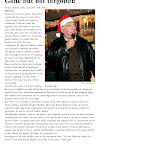

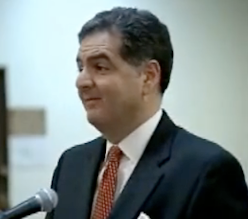
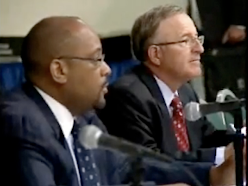
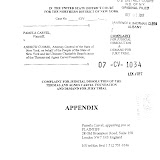
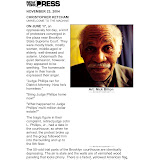
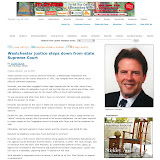
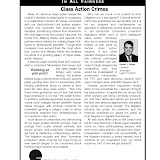

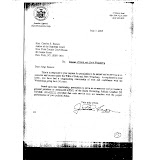
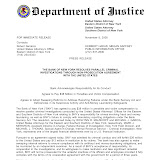
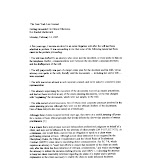
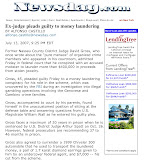
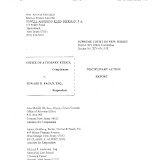
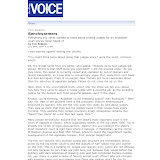

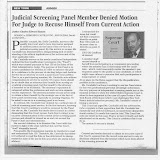

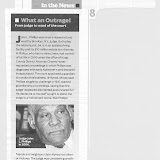
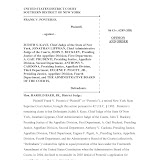
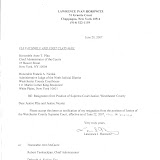
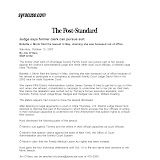
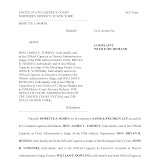

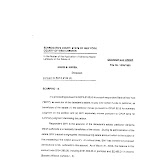
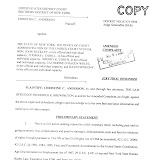
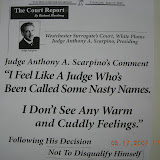
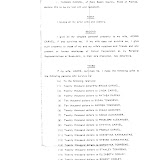
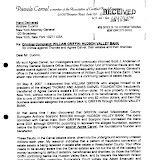
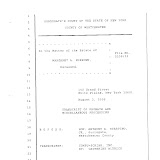
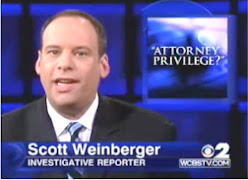
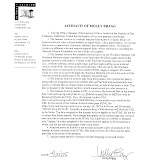
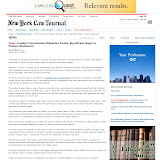
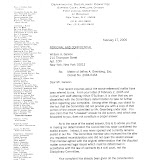
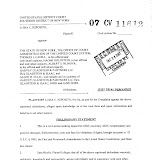
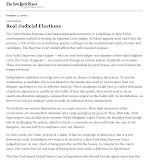
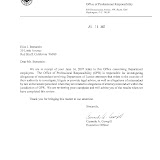
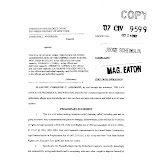
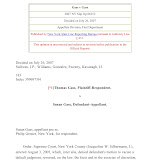
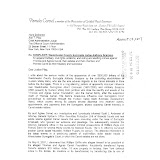

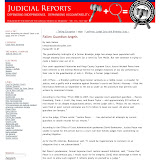
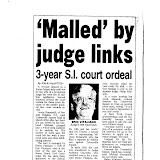
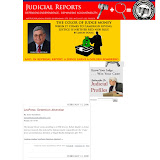
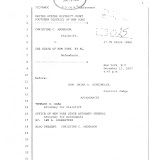
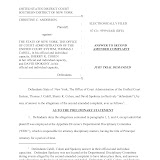
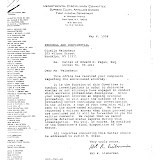
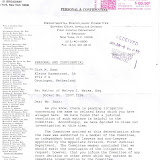
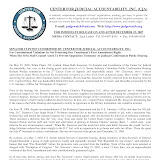
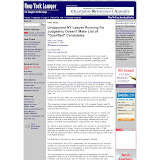
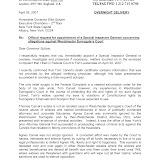
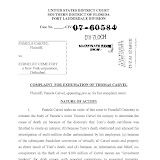
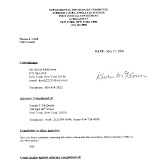
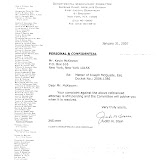
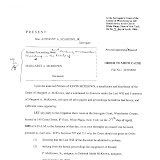
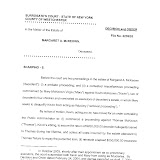
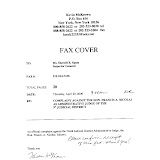
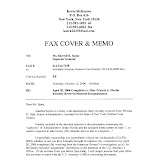
13 comments:
Tembeckjian's inaction is disgraceful- and criminal. They call it Misprison of Felony. He belongs in jail.
This is willful official misconduct by Tembeckjian and each member of the Commission. Would a jury buy their clown excuse that they didn't know about NY Penal Laws copied here?
Penal § 175.30 Offering a false instrument for filing in the second degree.
A person is guilty of offering a false instrument for filing in the second degree when,knowing that a written instrument contains a false statement or false information, he offers or presents it to a public office or public servant with the knowledge or belief that it will be filed with,registered or recorded in or otherwise become a part of the records of such public office or public servant.
And in regard to Judge's filings in civil suit § 210.05 Perjury in the third degree. A person is guilty of perjury in the third degree when he swears falsely.
And, of course the law which this judge and Tembeckjian and each Commission member fail to follow and which gives them sympathy for this poor Judge: § 195.00 Official misconduct.
A public servant is guilty of official misconduct when, with intent to obtain a benefit or deprive another person of a benefit:
1. He commits an act relating to his office but constituting an unauthorized exercise of his official functions, knowing that such act is unauthorized;
Did Judge Calderon offer the excuse that Mr.Tembeckjian and all the Commission members' continual whitewashing created an climate where any judge would be foolish to not be corrupt when it benefited him.
This clown Tembeckjian and the fools at CJC are a bad joke at our expense. COVERUP _ COVERUP & WHITEWASH
I think they should rename the DDC ..let's call it.. BARNUM BAILEY'S THREE RING CIRCUS..Tembeckjian is the RING MASTER...Friedberg is the CLOWN..and NAOMI GOLDSTEIN is the wind bag- hot air- con-artist!!!!
Were is John Sampson?
--John Sampson said he was going to look into some of the complaints?
--John Sampson said he was going to hold another hearing?
--Is John Sampson wotrking for the people the elected him?
--What is John Sampson doing while people are losing thier houses when they are not supposed to?
--What is john Sampson doing about thwe fact that if you are a minority or poor and you are charged with a crime it is almost certain that you will go to jail yet if you are not a minority or have money you will walk?
--What is John Sampson doing?
HE IS OUT CASHING THE BIG CHECKS HE IS GETTING AS A LOBBYIST INSTEAD OF WORKING FOR THE PEOPLE OF NEW YORK.
HE IS WORKING TO FATTEN HIS OWN BANK ACCOUNT
It appears they paid off Sampson, even the CJC said the corruption was too rampant many years ago, so they just continue to play the game...........
We need a FEDERAL MONITOR and PHONE NUMBER to call to report and investigate our complaints.......
SEND THE FEDS INTO OUR GRIEVANCE COMMITTEES AND START CHARGING THE CRUD! WHO CARES IF THEY HAVE A DEGREE IN LAW, THAT IS WHY THEY ARE DOING THIS, BECAUSE THEY HAVE A PIECE OF PAPER THAT COST THEM TO SAY THEY ARE A SOMEBODY!
I filed a valid complaint (including evidence)with the CJC against a Judge. It became a cover up, what a waste of time and energy. The CJC is a protection racket run by the gangsters. The CJC needs tobe closed, put them all out of work.
Who is this Stephen Coffey, I hope it is not the same Coffey that was DA in Albany, the guy who commentates on local television and radio stations to discuss highly publicized local/national civil & criminal cases...
so he talks about them but dismisses all suits in CJC offices..........nothing like a liar, I meant lawyer,NOT!
Who is this Stephen Coffey, I hope it is not the same Coffey that was DA in Albany, the guy who commentates on local television and radio stations to discuss highly publicized local/national civil & criminal cases...
so he talks about them but dismisses all suits in CJC offices..........nothing like a liar, I meant lawyer,NOT!
I proved complete witchhunt and was told to get another lawyer....
Multiple Federal Felonies are allowed in our Courts!
yes this Stephen Coffey was appointed to the Commission by now federal felony convicted former Senator Joe Bruno.
Coffey's law firm also stepped in to represent folks at the Suny Research Foundation which is under investigation by the Feds via Assistant US Attorney Sara Lord for billions in Medicaid fraud. there is a Times Union article on this.
former Senator Bruno's daughter came under scrutiny for having a good paying "no show" job at the Suny Research foundation as well.
so Coffey got on to the CJC by one of the "three men in the room" ( governor, shelly silver, bruno dividing up ny state )Bruno, who was one of the three men in the room for 12 plus years or so
He is a statewide guest lecturer for the New York State Bar Association and a national lecturer on Medicaid Fraud.
This is Stephen Coffey and he represents the defense.........
does he happen to be related to Sean Coffey ex US Attorney, with that Bernstein ...Firm?
Tembeckjian's inaction is disgraceful- and criminal. They call it Misprison of Felony. He belongs in jail
Did Bob sign that dismissal, he will just claim he never saw it....and Jean did it, it is all her fault!
Post a Comment